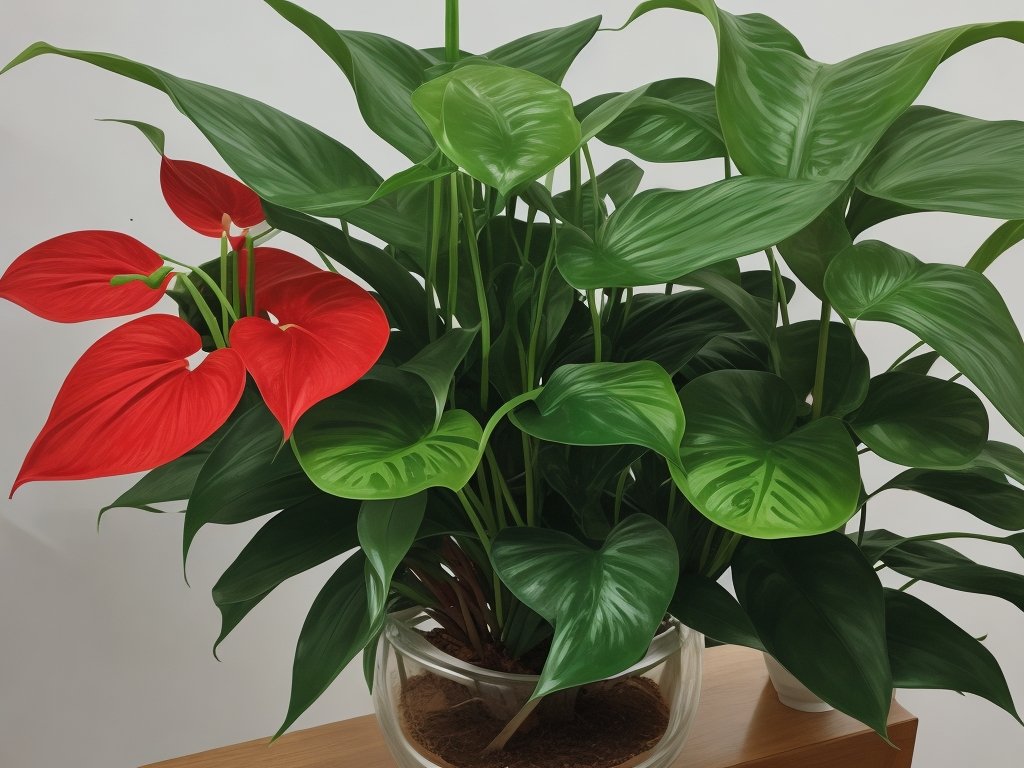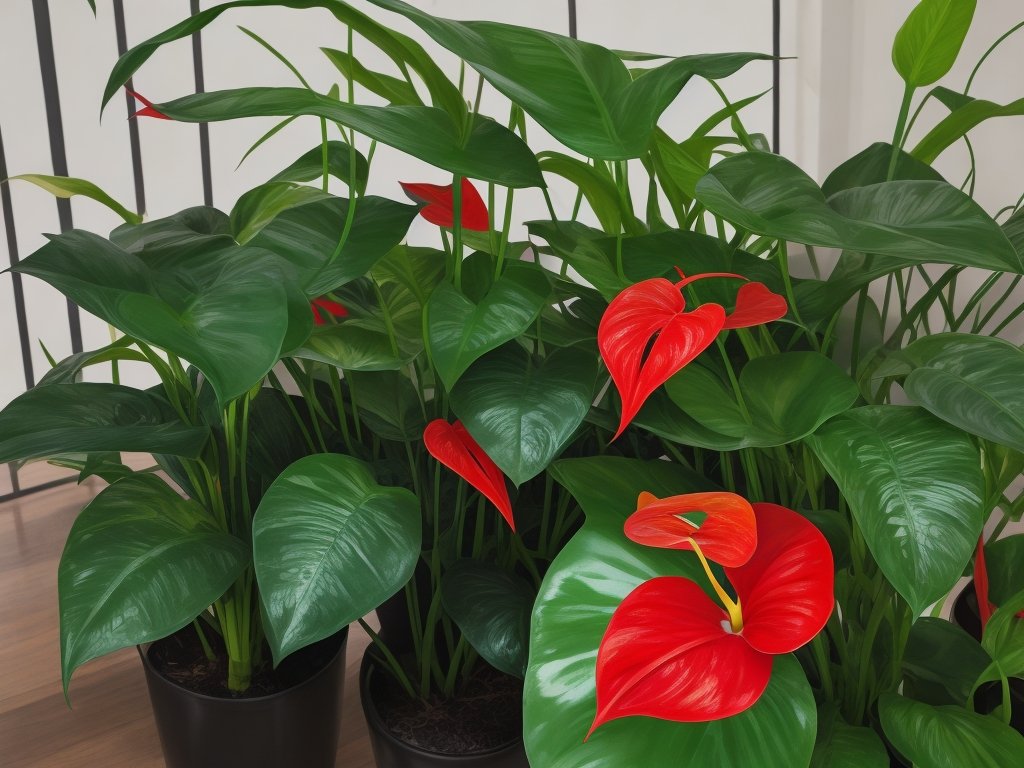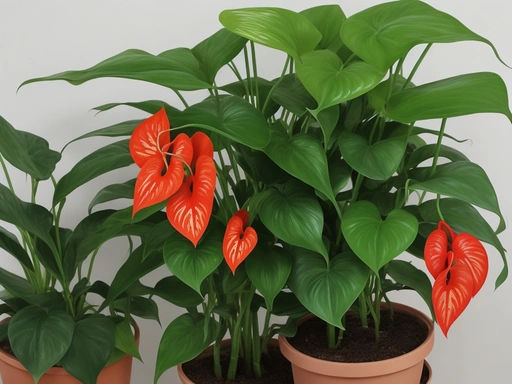Anthurium Winter Care Tips for Thriving Houseplants-Secrets Revealed!
Key Takeaways:
- Anthurium plants require a consistent temperature between 60-75°F during winter.
- Proper humidification is essential for Anthuriums to thrive during the winter months.
- Reduce watering frequency and avoid overwatering your Anthurium during winter.
- Protect your Anthuriums from drafts and provide them with bright, indirect light.
Are you worried about how to keep your Anthuriums healthy and thriving during the winter months? Well, you’re in luck! In this article, I will share with you all the tips and tricks you need to know about Anthurium winter care.
From understanding their specific needs to protecting them from cold drafts, preventing diseases and pests, and promoting growth, I’ve got you covered.
So, grab a hot cup of tea and let’s dive into the world of Anthurium winter care!
| Aspect | Recommendation |
|---|---|
| Temperature | Keep the plant in a consistent temperature between 60°F (15°C) and 75°F (24°C). Avoid exposing it to temperatures below 55°F (13°C). |
| Light | Place the plant in a bright location away from direct sunlight. Indirect or filtered light is ideal for Anthuriums. |
| Humidity | Maintain high humidity levels of 60% to 80%. Use a humidifier or place the pot on a tray of water with pebbles to increase humidity. |
| Watering | Water the plant when the top 1-2 inches of soil are dry. Do not overwater as it can lead to root rot. Ensure proper drainage in the pot. |
| Fertilizer | Feed the plant with a balanced, water-soluble fertilizer every 2-4 weeks during the growing season. Reduce fertilization frequency in winter. |
| Pruning | Prune any yellow or wilted leaves to maintain the plant’s appearance. Remove spent flowers to promote new blooms. |
| Pest Control | Inspect the plant regularly for pests like mealybugs or aphids. Use insecticidal soap or neem oil to control infestations. |
| Rest Period | During winter, reduce watering and provide a cooler environment (around 55°F to 65°F or 13°C to 18°C) for 4-6 weeks to encourage blooming during spring. |
Why Anthuriums Need Winter Care
Anthuriums need winter care to maintain their health and ensure optimum growth during the colder months.
Understanding the Needs of Anthurium Plants
Understanding the needs of Anthurium plants is essential for their overall health and growth.
They require specific temperature, humidity, light, watering, and nutrient conditions to thrive.
It’s important to provide the right environment, protect them from cold drafts, prevent diseases and pests, and promote growth through proper care.
Keep these needs in mind to ensure your Anthurium plants stay happy and healthy.
The Importance of Winter Care for Anthuriums
Proper winter care is essential for Anthuriums to thrive.
It ensures their survival during the colder months and sets the stage for healthy growth when spring arrives.
Winter care involves providing the right temperature, humidity, light, and watering for Anthuriums.
It also includes protecting them from cold drafts, preventing diseases and pests, and promoting growth through soil quality, fertilization, and pruning.
By prioritizing winter care, you can help your Anthuriums stay healthy and vibrant throughout the season.
Indoor Anthurium Care During Winter
During the winter, ensure your indoor Anthuriums are kept in the right temperature, humidity, light, and water conditions.
Providing the Right Temperature for Anthuriums
Anthuriums thrive in temperatures between 70-85°F (21-29°C) during the day and around 60-70°F (15-21°C) at night.
Avoid exposing them to temperatures below 60°F (15°C) as it can damage the plant.
Provide consistent warmth and avoid sudden temperature fluctuations to keep your Anthurium happy and healthy during winter.

Proper Humidity Levels for Anthuriums in Winter
Maintaining proper humidity levels is important for Anthuriums in winter. Aim for a humidity level of around 50-60%.
You can achieve this by placing a humidifier nearby or using a pebble tray filled with water.
Mist the leaves occasionally, but avoid overwatering as it can lead to root rot.
Maintaining Adequate Light for Anthuriums Indoors
Maintaining adequate light for Anthuriums indoors is essential for their growth and health.
Place your Anthuriums in a well-lit area, preferably near a north or east-facing window.
Avoid direct sunlight, as it can scorch the leaves.
If natural light is limited, supplement with artificial grow lights to provide the necessary brightness.
Rotate the plant regularly to ensure even light distribution.
Protecting Anthuriums from Cold Drafts
Protect your Anthuriums from cold drafts to ensure their health and well-being during winter.
Identifying and Avoiding Cold Drafts in the Home
To identify and avoid cold drafts in your home, start by carefully inspecting windows and doors for any gaps or cracks that may be letting in cold air.
Seal these areas using weatherstripping or caulk.
Consider using draught excluders or insulation to minimize cold air entry.
Finally, avoid placing your Anthuriums near windows or doors where drafts are more likely to occur.

Using Draught excluder or Insulation to Minimize Cold Air Entry
To minimize cold air entry and protect your Anthuriums during winter, you can use draught excluders or insulation.
These methods help to seal any gaps and prevent drafts from entering your home.
By blocking cold air from coming in, you can maintain a more stable and suitable environment for your Anthuriums.
Moving Anthuriums Away from Windows or Doors
To protect your Anthuriums from cold drafts, it’s important to move them away from windows or doors during winter.
These areas are prone to drafts that can cause temperature fluctuations, which can be harmful to your plants.
Place them in a location that is away from direct exposure to cold air to ensure their well-being.

Preventing Anthurium Diseases and Pests in Winter
To prevent diseases and pests from affecting your Anthuriums in winter, focus on proper hygiene practices and natural pest control methods.
Common Diseases and Pests that Affect Anthuriums in Winter
Anthuriums are susceptible to common diseases and pests during winter. The most common diseases include root rot, leaf spot, and powdery mildew.
Pests such as aphids, mealybugs,Anthuriums to repel pestso infest your plants.
Proper hygiene and regular inspection are key to preventing and managing these issues.
Proper Hygiene Practices for Anthuriums in Winter
During winter, proper hygiene practices are important to maintain the health of your Anthurium plants. Here are some key tips:
- Cleanliness: Regularly remove any fallen leaves, debris, or dead plant material from around the Anthurium. This helps prevent the buildup of pests and diseases.
- Sterilize tools: Before using any tools on your Anthurium, make sure they are clean and sterilized. This prevents the spread of pathogens.
- Avoid overwatering: In winter, Anthuriums require less water. Overwatering can lead to root rot and other diseases. Only water when the top inch of soil is dry.
- Avoid splashing water on leaves: Water droplets on leaves can create a moist environment that promotes fungal and bacterial growth. Direct water carefully to the soil.
- Prune selectively: If you notice any diseased or damaged leaves or stems, prune them off immediately. This helps prevent further spread of diseases.
- Quarantine new plants: If you bring in any new Anthurium plants during winter, keep them separate from the rest for a few weeks to monitor for pests or diseases.
Natural Pest Control Methods for Anthuriums in Winter
To naturally control pests on your Anthuriums during winter, there are a few effective methods you can try:
- Neem oil spray: Neem oil is a popular organic insecticide that can help control common pests like aphids, mealybugs, and spider mites. Mix neem oil with water and apply it to the leaves and stems of your Anthurium.
- Soap spray: Mix a few drops of mild liquid soap with water and spray it onto the affected areas of your plant. This can smother insects like aphids and thrips.
- Beneficial insects: Introduce beneficial insects like ladybugs or lacewings into your indoor garden. They feed on pests and can help keep your Anthuriums pest-free.
- Garlic spray: Create a garlic spray by blending garlic cloves with water and straining the mixture. Spray this solution onto your Anthuriums to repel pests.
Remember, it’s important to regularly inspect your plants for any signs of pests and take immediate action to prevent infestations from spreading.
Promoting Anthurium Growth in Winter
Keep your anthurium thriving in the winter by providing nutrient-rich soil and regular fertilization.
Pruning during this season can also encourage new growth.
Providing Nutrient-Rich Soil for Anthuriums
To provide nutrient-rich soil for Anthuriums, you can follow these steps:
- Use a well-draining soil mix: Anthuriums prefer soil that drains well to prevent the roots from sitting in water. A mixture of equal parts peat moss, perlite, and orchid bark is ideal.
- Add organic matter: Incorporate organic matter into the soil mix to provide essential nutrients. You can use compost, well-rotted manure, or coconut coir to enrich the soil.
- Use slow-release fertilizer: Anthuriums benefit from a slow-release fertilizer that provides nutrients over an extended period. Look for a balanced formula specifically designed for indoor plants.
- Avoid over-fertilizing: Too much fertilizer can burn the roots of Anthuriums. Follow the instructions on the fertilizer package and apply it sparingly to avoid nutrient overload.
- Monitor pH levels: Anthuriums prefer slightly acidic soil with a pH level between 5.5 and 6.5. You can test the pH using a soil testing kit and adjust it by adding amendments if necessary.
Remember, providing nutrient-rich soil is essential for the health and growth of your Anthurium plants.
With the right soil mix and proper fertilization, your Anthuriums will thrive throughout the winter season.
Fertilizing Anthuriums for Winter Growth
During winter, it’s important to adjust your fertilizer routine for Anthuriums. You should decrease the frequency of fertilizing to once every 6-8 weeks.
Use a balanced fertilizer with equal amounts of nitrogen, phosphorus, and potassium.
Follow the instructions on the fertilizer packaging. Avoid over-fertilizing, as it can harm the plant.
Pruning Anthuriums in Winter to Encourage New Growth
To encourage new growth in Anthuriums during winter, pruning is a helpful technique. Here are a few steps to follow:
- Identify any dead or damaged leaves and remove them carefully.
- Trim back any leggy or overgrown stems, leaving about an inch of the stem intact.
- Cut off any flowers that have wilted or finished blooming.
- Take care not to remove too much foliage, as Anthuriums need leaves to generate energy.
- Prune selectively to shape the plant and promote new growth from the nodes.
Remember to use clean and sterilized pruning tools for the best results.
Common Winter Care Mistakes to Avoid
Don’t make these common mistakes when caring for your Anthurium plants during winter.
Overwatering Anthuriums in Winter
Overwatering Anthuriums in winter can be detrimental to their health. It’s important to avoid excessive moisture in the soil, as it can lead to root rot and other fungal diseases.
Instead, allow the top inch of soil to dry out before watering again.
Always check the moisture levels before giving your Anthurium more water.
Placing Anthuriums in Frequent Temperature Fluctuations
Placing Anthuriums in frequent temperature fluctuations can be detrimental to their health. These plants thrive in stable temperatures, so sudden shifts can cause stress and damage.
To prevent this, find a location with consistent temperatures and avoid placing them near drafts or heat sources.
Overlooking Anthuriums’ Nutritional Needs in Winter
Anthuriums’ nutritional needs are often overlooked in winter, but it’s essential to provide them with proper nourishment.
Make sure to use a well-balanced fertilizer that is specifically formulated for indoor plants.
Provide the necessary nutrients to support their growth and overall health during the winter months.
Frequently Asked Questions
How often should I water my Anthurium in winter?
During winter, you should water your Anthurium less frequently. Allow the top inch of soil to dry out between waterings to prevent overwatering, which can lead to root rot.
Stick your finger into the soil to check its moisture level before watering.
Aim for a slow, deep watering when necessary.
Can Anthuriums tolerate low temperatures?
Anthuriums cannot tolerate low temperatures well. They prefer temperatures between 60-70°F (15-21°C).
Exposing them to temperatures below 55°F (13°C) can cause damage to their leaves and roots.
It’s important to keep them in a warm and stable environment during the winter months to ensure their health and growth.
Can I place my Anthurium near a heating vent?
Placing your Anthurium near a heating vent is not recommended.
The hot, dry air from the vent can cause the plant’s leaves to wilt and dry out.
It’s best to keep your Anthurium in a location with consistent temperature and humidity levels.
How do I know if my Anthurium is getting enough light in winter?
To determine if your Anthurium is receiving enough light during winter, observe its overall appearance and behavior. If the leaves are dark green and healthy-looking, this is a good sign.
However, if the leaves are pale, elongated, or dropping, it may indicate a lack of light.
Additionally, if your Anthurium is not producing flowers or if the existing flowers are small and pale, it could be a sign of inadequate light. Overall, Anthuriums thrive in bright, indirect light, so ensure they are placed in a well-lit area during the winter months.
Final Verdict
Providing proper winter care for your Anthurium plants is essential to ensure their health and growth during the colder months. Understanding their specific needs for temperature, humidity, light, and watering is crucial.
Protecting them from cold drafts and preventing diseases and pests are also important aspects of winter care.
By following these guidelines and avoiding common mistakes, you can promote the growth of your Anthuriums and enjoy their beauty year-round. Remember to regularly monitor and adjust their care as needed.
With the right attention and care, your Anthuriums will thrive and bring joy to your home during the winter season.






